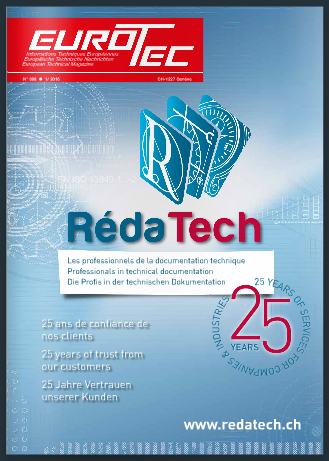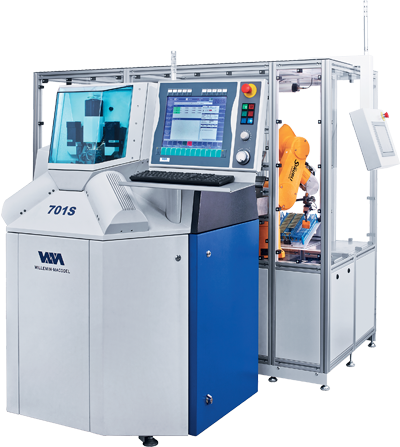
15 Gen New strategies for watchmaking
At Baselworld, Willemin-Macodel will present the 701S machine that was highlighted as a major innovation during the last EMO in Hanover. In Basel, this little machine with parallel kinematics in Delta architecture will be presented as a machining solution dedicated to watchmaking.

Equipped with its loading and unloading system for standard watch baskets,
the 701S machine can be networked with multiple other machines and thus
become an utra-flexible transfer machining centre.
The machine to be discovered in Basel will be equipped with features suited to the production of parts for watches, including watch plates, bridges, dials and indexes. It will present a unique flipping device for complete machining of the watch plate, on both sides and on its edges, as well as palletizing and automation systems. Thanks to an ideal association of parallel kinematics, a very low moving mass and very high rigidity, the quality and the accuracy of interpolation are exceptional; this without any limitation of the diameter of the tool that can start from a few hundredths of mm. Dedicated machining strategies by interpolation and macros will also enable the presentation of machining operations specific to the field such as decoration, engraving, diamond polishing or shaping. Perfectly equipped, including for the recovery of precious metals or hard machining, the 701S is a true watchmaking machine.
Reversed machining
In 2013 we wrote: “The idea of doing a machine equipped with a parallel architecture as opposed to a serial kinematics is not new, but it has never reached such a degree of attainment so far. After several years of development on the basis of a concept of the EPFL, Willemin-Macodel has developed a delta machine of sub-micron precision”. The milling spindle is fixed on a fixed gantry overlooking a 3 axes table driven by a delta robot. The embedded masses are therefore very low; marrying very high dynamics and rigidity. Mr. Patrick Haegeli, Member of the Executive Board says: “Whatever the machine is doing, straight lines or curves, all movements are interpolated and made by the three arms, tools are always at the right speed, without slowing down or jerking, quality of machining and tool life are therefore maximum and the results from the market confirms this beautifully”.
Combined benefits…
If we compare the common technologies available on the market for the watch parts, we can separate them into two categories: single spindle machining centres which are preciseand flexible but less productive and transfer machines that allow to achieve very short cycle times but which are complex to implement and require advanced skills.
…compared to a single spindle machining centre
With the 701S machine, Willemin-Macodel offers a solution that combines the advantages of both technologies. Working parts to parts, it offers higher performance than single spindle machining centres (in the area of the micro-mould, customers announce machining time divided by eight. In the case of typical parts of the watch industry, these gains reach 1.5 to 2 x, but can be significantly larger as in this case of indexes produced by one of the first customer of the 701S for whichimprovement is greater than 10 x). M. Zaugg, Director of applications, adds: “For the realization of a typical watch plate, a classic machining centre requires between 50 and 70 tools, on the 701S, with the strategy by interpolation, we need only 12 tools. This also generates significant gains in terms of tooling’s costs. With a compact 36 tools store, it is thus possible to triple each tool. As the 701S features a camera operated programmable tools analysing system (which works at the speed of working rotation to ensure maximum precision), coupled with a highly efficient cleaning system it is possible to guarantee roundness control as well as the analyse of the edge and the tool weariness before any machining”. “With tools of diameters of 0.05 mm for example, variations in the order of the micron between stopped and rotating (at 80,000 rpm) positions are likely, it is why we measure at work speed” adds Mr. Haegeli.
…and compared to a transfer machine
The 701S machine presented in Basel will be equipped with an automatic robotised cell that provides loading, unloading, control and cleaning (other options are possible). This system, once associated with several 701S machines becomes a direct competitor to transfer machines. For a roughly equivalent investment, Willemin-Macodel offers an ultra-precise solution with almost null set-up time and which offers a very high guarantee of operation. Mr. Zaugg says: “If there is a problem with a transfer machine, production is arrested. If a 701S machine of a production cell is in maintenance, the pace is limited but the production of each finished part remains guaranteed.
Each machine can be used individually thanks to its integrated 18-position palletizer. The flexibility of the machining cell also allows using a stand-alone machine to achieve prototype parts for example while the others continue to work on the series. Conversely, maintenance on the robot may be considered in the process of production, without interruption of the individual machining cycles”.

The decoration possibilities offered by the 701S are almost limitless, which
opens new horizons to watch designers.
The quest of no set-up time
What was utopia since the arrival of the CNC machines is now a reality. With its embedded technology, tools analysis in real working condition, a device for quick tool store management and outstanding thermal stability, the 701S machine allows the start of a series without very high qualification, but most importantly, without any set-up time. Simply insert the CNC program into the machine, enclose the tool store and start production. The first part will comply with watchmaking requirements.
Simplicity, reliability and compactness
The watchmaking specialists wishing to product complete kits of watches (watch plates and bridges for example) have a very flexible production tool that enables them to manage the production dynamically with a cell of 701S machines. Both machine and robotic cell programming have been simplified to the maximum, including using an interface developed inhouse. The machine is equipped with a complete chip recuperation system including continuous washing of the machining area and an integrated filtration system. We can add that all the peripherals are integrated within the machine on a floor space of about one square meter. The Director points out: “Our customers are not only surprised by the performance of the 701S, but also by its simplicity. An operator masters it in less than a day”. He adds: “Another advantage identified by users is the rapidity with which the machine is stable. They restart the machine on Monday morning after two days of pause and without preheating the machine, the first part is good without needing to fine tune anything”.
Specific cycles
One of the main assets of the company is the service offered to complement its products. With the 701S machine this philosophy is taken even further. The company works closely with manufacturers of tools to enable them to develop tools that can take advantage of the capabilities of the machine. Willemin-Macodel also works with CAD/CAM providers. Mr. Zaugg explains: “Today we are technologically more advanced and we are clearly not at the limits of the machine, in collaboration with customers and partners, we are permanently improving the overall performance of machining”. To do this, the Delémont specialists are regularly in contact with customers. With regard to watchmaking, specific cycles have already been developed, especially for achieving pivots or threads but also special surface finishes as turning or planning aspects The limits of technology With accuracies close to the capacities of measuring machines, one must be careful while measuring and analysing. It becomes very hard to say if the difference comes from the machining or from the measure. In this regard Mr. Zaugg says: “In tests we discovered that a mere degreasing fluid was enough to cheat the measure and label the parts as out of range”. In order to answer to the dimensional challenges of its customers, the company has acquired the necessary material to offer full guarantee of high quality control and precision.
The biggest challenge?
“We are still daily impressed by the performance of the machine and the results reached by our customers demonstrate that the concept allows very significant quality and cycle time improvements. The 701S machine forces us to rethink all the mastered machining codes and to reinvent new standards. These innovating strategies bring new perspectives in watchmaking design” concludes Julian Zaugg. Interested in producing watch parts in a different and highly effective way? The company’s specialists will be delighted to meet with you on the next watchmaking trade shows in Switzerland. During Baselworld from March 19 to 26, 2015, visitors will also be able to discover other horological Willemin-Macodel solutions on stand F22 in Hall 4U.
EUROTEC
Willemin-Macodel SA
Communance 59
CH-2800 Delémont
Tel. + 41 32 427 03 03
www.willemin-macodel.com
sales@willemin-macodel.com

